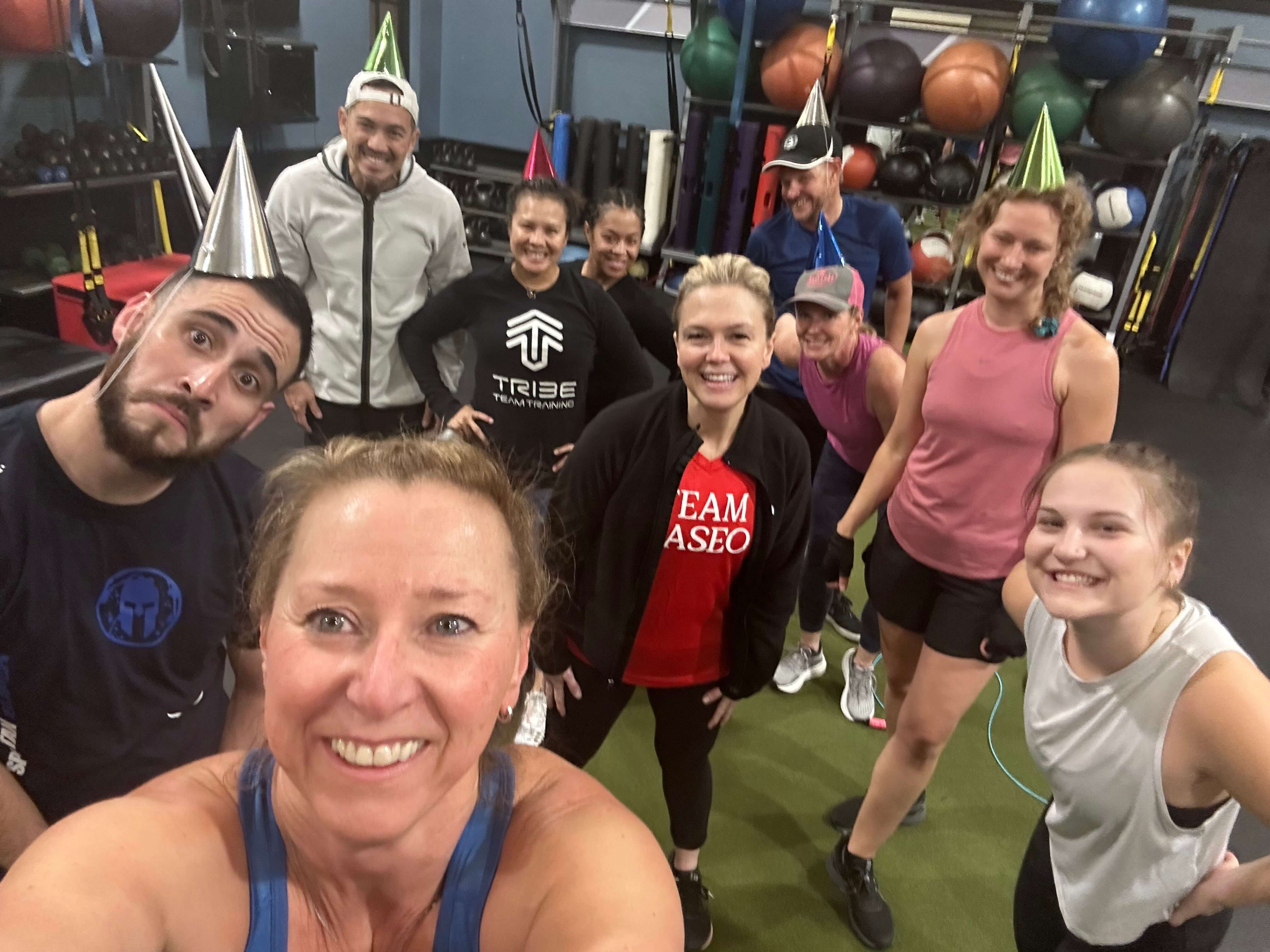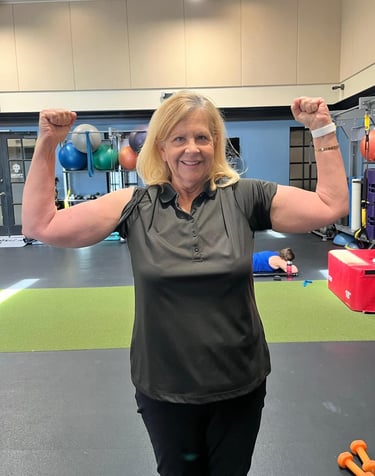What is osteoporosis? (and what you can do to prevent it)
May 1st, 2023 | 4 min. read
By Jen Azevedo

When we hear the word osteoporosis, an image of a frail 88-year-old great-grandmother comes to mind — stooped over as she walks, leaning heavily on her cane.
Osteoporosis is a disease for women.
Osteoporosis is a disease for old people.
Osteoporosis doesn't run in my family, so I won’t get it.
There are a lot of myths about osteoporosis. It is precisely this mindset that gets us into trouble. Osteoporosis is a silent progressive disease, and you may not realize you have it until something disastrous happens.
May is National Osteoporosis Awareness and Prevention Month. At the Paseo Club, we care about our members’ health and well-being and like to do our part to educate them about all health conditions.
In this article, you will learn what osteoporosis is, how many people have osteoporosis, who is at risk for getting osteoporosis, and how you can prevent it.
.png?width=375&height=323&name=cropped_compressedSusan2%20-%20Edited%20(2).png) What is osteoporosis?
What is osteoporosis?
Osteoporosis is a health condition in which people lose bone mass and integrity, making bones weak and at high risk for fractures.
When you have osteoporosis, your bones can become so fragile that a simple fall from a standing position can cause a fracture, whereas for most people, it would barely cause a bruise. Even such simple tasks as bending, lifting, or coughing can cause a fractured bone.
Advanced osteoporosis is associated with a shorter lifespan, according to a Danish study conducted in 2015.
How many people have osteoporosis?
One out of every two women and one in four men aged 50 and older will have an osteoporosis-related fracture in their lifetime. This totals about 10 million Americans with osteoporosis, and about 34 million more are at risk.
Why do people get osteoporosis?
Many people are familiar with age and gender as determining factors, but there are many other reasons that people develop osteoporosis.
.jpg?width=375&height=500&name=comp_IMG-0189%20(2).jpg) Age
Age
Bone mass is at its strongest in early adulthood. But it begins to decline after the age of 30. People 50 and older are at higher risk for osteoporosis.
Gender
Women are more likely than men to develop osteoporosis, especially after menopause, due to reduced estrogen levels.
Genetics
A family history of osteoporosis can increase the chance of developing it.
Lifestyle factors
Lack of exercise, smoking, excessive alcohol consumption, and a diet low in calcium and vitamin D increases the risk of osteoporosis.
Hormonal imbalances
Low levels of testosterone in men, and low levels of estrogen in women, can contribute to the development of osteoporosis.
Do medical issues put you at greater risk for osteoporosis?
Certain medical conditions and medications can increase your risk of developing osteoporosis. Your doctor will need to closely monitor your bone health if you have one of these health issues or take the listed medications.
- Chronic kidney disease
- History of missed periods
- Recipient of an organ transplant
- Long-term use of corticosteroids
- History of bariatric (weight loss) surgery
- Blood diseases such as multiple myeloma
- Long-term use of some anticonvulsant drugs
- Celiac disease or inflammatory bowel disease
- Hormone treatment for breast or prostate cancer
- An overactive thyroid, parathyroid, or adrenal glands
 Do people know when they have osteoporosis?
Do people know when they have osteoporosis?
What makes osteoporosis so scary, is that there are typically no symptoms in the early stages of bone loss. Osteoporosis is often referred to as a silent disease. This is why eating right, exercising, and receiving bone density scans are so important.
You can also be aware of these signs that may occur once your bones weaken:
- A stooped posture
- A loss of height over time
- A bone that breaks easier than expected
- Back pain caused by a fractured or collapsed vertebra
7 steps to prevent osteoporosis
You can take several steps to help reduce the risk or prevent osteoporosis. It is best to employ all of these steps as much as possible to maximize your chance of having healthy bones for the duration of your lifespan.
1. Calcium: Calcium is crucial to building and maintaining healthy bones. Sources of calcium include dairy products, leafy green vegetables(kale, collards, spinach, and chard), almonds, bone broth, and fortified foods like cereal and orange juice.
2. Vitamin D: Vitamin D is Calcium’s partner-in-crime. It works to help the body absorb calcium. Good sources of vitamin D are fatty fish, egg yolks, and fortified foods like milk and cereal. Sunlight is also a natural source of vitamin D. Many people are low in Vitamin D, especially in the winter. Supplementing with Vitamin D can be the most effective way to maintain proper levels.
3. Exercise: Weight-bearing exercises are essential to help build and maintain bone density. Walk, jog, dance, play tennis, and lift weights to support bone health. Resistance exercises such as weight lifting, bodyweight exercises, and using resistance bands also support bone health. Exercises that require you to balance (yoga) help too.
4. Stop smoking: Smoking can lead to a host of problems with your health, and osteoporosis is one of them. Smoking decreases bone density and increases the risk of fractures.
.jpg?width=400&height=300&name=comp_enggsnthings4%20(2).jpg) 5. Limit alcohol: Limit alcohol intake to a maximum of one drink per day for women and two drinks per day for men — and, no, that does not mean having all of the drinks on the weekend. Drinking too much alcohol can decrease bone density and increase the risk of fractures.
5. Limit alcohol: Limit alcohol intake to a maximum of one drink per day for women and two drinks per day for men — and, no, that does not mean having all of the drinks on the weekend. Drinking too much alcohol can decrease bone density and increase the risk of fractures.
6. Learn about your medications: Some medications can contribute to bone loss. Consult with your doctor to see if there are alternatives.
7. Get bone density scans: Bone density scans can help detect early signs of osteoporosis and allow for treatment.
Treatment for Osteoporosis
Prevention is the most effective method to protect yourself from getting osteoporosis. But if your doctor sees the beginning signs of weakening bones (osteopenia), there are steps you can take, including exercises, dietary changes and/or supplementation, and medication.
%20(1).png?width=375&height=470&name=cropped_compressedIMG_9700%20%20(1)%20(1).png) Your health matters
Your health matters
Taking care of your body and mind through exercise, good nutrition, developing strong social connections, and self-care is the key to a happy, fulfilled, and long life.
Osteoporosis is a health condition that affects the strength of bones. It is primarily preventable with attention to a few important details. By following these steps, your bones can stay strong and resilient, even into your golden years.
The Paseo Club is a social club in the Santa Clarita Valley that supports members of all ages in their fitness and health goals. We offer over 60 fitness classes each week, tennis and pickleball courts, and a junior Olympic pool.
When members aren’t busy working out, they can be found relaxing at the cafe, getting a massage or facial at the spa, or visiting with friends at one of our member mixers.
If you are interested in a community-centered fitness center, then the Paseo Club may be the best place for you. Schedule a tour and meet members, staff, and instructors.
To learn more about low-impact fitness, check out these three articles.
- What are the benefits of Liquid Cardio?
- Yoga vs. Pilates (and which is best for you)
- What is TRX and Core class at the Paseo Club?
Jen Azevedo is a tennis professional, pickleball professional, personal trainer, group exercise instructor, and the general manager of the Paseo Club. She loves the community at the Paseo Club and that it is also a safe and fun place for her daughter. Jen’s favorite activities are joining her tribe for trail races or her partners for tennis matches. Occasionally Jen slows down to relax with a book — she reads over 100 a year!


